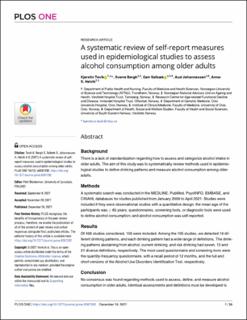| dc.contributor.author | Tevik, Kjerstin Elisabeth | |
| dc.contributor.author | Bergh, Sverre | |
| dc.contributor.author | Selbæk, Geir | |
| dc.contributor.author | Johannessen, Aud | |
| dc.contributor.author | Helvik, Anne-Sofie | |
| dc.date.accessioned | 2022-01-26T13:39:54Z | |
| dc.date.available | 2022-01-26T13:39:54Z | |
| dc.date.created | 2021-12-21T09:43:14Z | |
| dc.date.issued | 2021 | |
| dc.identifier.citation | Tevik, K., Bergh, S., Selbæk, G., Johannessen, A. & Helvik, A.-S. (2021). A systematic review of self-report measures used in epidemiological studies to assess alcohol consumption among older adults. PLoS One, 16(12), Artikkel e0261292. | en_US |
| dc.identifier.issn | 1932-6203 | |
| dc.identifier.uri | https://hdl.handle.net/11250/2839488 | |
| dc.description.abstract | Background: There is a lack of standardization regarding how to assess and categorize alcohol intake in older adults. The aim of this study was to systematically review methods used in epidemiological studies to define drinking patterns and measure alcohol consumption among older adults.
Methods: A systematic search was conducted in the MEDLINE, PubMed, PsycINFO, EMBASE, and CINAHL databases for studies published from January 2009 to April 2021. Studies were included if they were observational studies with a quantitative design; the mean age of the participants was ≥ 65 years; questionnaires, screening tools, or diagnostic tools were used to define alcohol consumption; and alcohol consumption was self-reported.
Results: Of 492 studies considered, 105 were included. Among the 105 studies, we detected 19 different drinking patterns, and each drinking pattern had a wide range of definitions. The drinking patterns abstaining from alcohol, current drinking, and risk drinking had seven, 12 and 21 diverse definitions, respectively. The most used questionnaire and screening tools were the quantity-frequency questionnaire, with a recall period of 12 months, and the full and short versions of the Alcohol Use Disorders Identification Test, respectively.
Conclusion: No consensus was found regarding methods used to assess, define, and measure alcohol consumption in older adults. Identical assessments and definitions must be developed to make valid comparisons of alcohol consumption in older adults. We recommend that alcohol surveys for older adults define the following drinking patterns: lifetime abstainers, former drinkers, current drinkers, risk drinking, and heavy episodic drinking. Standardized and valid definitions of risk drinking, and heavy episodic drinking should be developed. The expanded quantity-frequency questionnaire including three questions focused on drinking frequency, drinking volume, and heavy episodic drinking, with a recall period of 12 months, could be used. | en_US |
| dc.language.iso | eng | en_US |
| dc.relation.uri | https://journals.plos.org/plosone/article/file?id=10.1371/journal.pone.0261292&type=printable | |
| dc.rights | Navngivelse 4.0 Internasjonal | * |
| dc.rights.uri | http://creativecommons.org/licenses/by/4.0/deed.no | * |
| dc.title | A systematic review of self-report measures used in epidemiological studies to assess alcohol consumption among older adults | en_US |
| dc.type | Peer reviewed | en_US |
| dc.type | Journal article | en_US |
| dc.description.version | publishedVersion | en_US |
| dc.rights.holder | © 2021 Tevik et al. | en_US |
| dc.source.volume | 16 | en_US |
| dc.source.journal | PLOS ONE | en_US |
| dc.source.issue | 12 | en_US |
| dc.identifier.doi | https://doi.org/10.1371/journal.pone.0261292 | |
| dc.identifier.cristin | 1970887 | |
| dc.source.articlenumber | e0261292 | en_US |
| cristin.ispublished | true | |
| cristin.fulltext | original | |
| cristin.qualitycode | 1 | |

